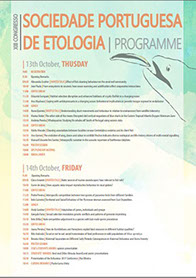| 13th October, THURSDAY
09:00 REGISTRATION
09:30 Opening Remarks
09:50 ALEXANDRA GRUTTER | INVITED TALK | Effect of fish cleaning behaviour on the coral reef community
10:40 José Paula | From ecosystems to neurons: how ocean warming and acidification affect cooperative interactions
11:00 COFFEE BREAK
11:20 Eduardo Sampaio | Habitat selection disruption and enhanced boldness of cryptic flatfish in a changing ocean
11:40 Ana Maulvaut | Coping with antidepressants in a changing ocean: behavioural implications in meagre exposed to venlafaxine
12:00 LUNCH
14:00 NUNO QUEIROZ | INVITED TALK | Understanding shark movements and behaviour in relation to environment from satellite telemetry
14:50 Marisa Vedor | The other side of the moon: disrupted diel vertical migrations of blue sharks in the Eastern Tropical Atlantic Oxygen
Minimum Zone
15:10 Andreia Pereira | Whalequakes: Studying fin whales off South of Portugal using seismic data
15:30 COFFEE BREAK
15:50 Nádia Morado | Cleaning associations between facultive wrasse Centrolabrus exoletus and its client fish
16:10 Ana Gomes | The evolution of song, dance and colour in estrildid finches indicates diverse ecological and life-history drivers of multi-modal signalling
16:30 Manuel Eduardo Dos Santos | Intraspecific variation in the acoustic repertoire of bottlenose dolphins
16:50 POSTER SESSION
18:00 SPE PLENEARY MEETING
20:00 SOCIAL DINER
| 14th October, FRIDAY
09:30 Opening Remarks
09:50 CLARA AMORIM | INVITED TALK | Biotic sources of marine soundscapes: how relevant is fish talk?
10:40 Karen de Jong | Does aquatic noise impact reproductive behaviour in vocal gobies?
11:00 COFFEE BREAK
11:20 Pedro Pereira | Interspecific competition between two species of passerine birds from different families
11:40 Inês Carneiro | Territorial and social behaviour of the pyrenean desman assessed from scat deposition
12:00 LUNCH
14:00 ANDY GARDNER | INVITED TALK | Adaptation of genes, individuals and groups
14:50 Gonçalo Faria | Sexual selection modulates genetic conflicts and patterns of genomic imprinting
15:10 Inês Órfão | Male competitive adjustment in a species with last-male sperm precedence
15:30 COFFEE BREAK
15:50 Joana Pereira | How do Bumblebees and Honeybees exploit food resources in different habitat qualities?
16:10 Rita Andrade | To eat or not to eat: social transmission of food preferences in wild populations of Mus spretus
16:30 Renata Alves | Maternal separation on different early periods: consequences in maternal behaviour and dams anxiety
16:50 POSTER SESSION
18:00 FCUL's STUDENTS AWARD | Sofia Mendes, Mariana Nunes, Rodrigo Vieira | Quantitative discrimination in Gambusia affinis
18:15 STUDENTS' AWARDS | Best oral (Vítor Almada Award) and poster presentations
18:30 Presentation of the Behaviour 2017 Conference | Rui Oliveira
18:45 CLOSING REMARKS | Paulo Gama Mota
The University of Queensland, Austrália
Alexandra Grutter
Effect of fish cleaning behaviour on the coral reef community
On the Great Barrier Reef, most fishes engage the cleaning services of the cleaner wrasse Labroides dimidiatus, which removes huge numbers of ectoparasites, mostly blood-sucking gnathiids isopods, from clients. Over 25 years, we tested the consequences of these complex behaviours to participants and the wider community.
The removal of cleaners from reefs caused a 4-fold increase in gnathiid loads on caged fish within 12 h, but no effect after 6 months on all fish and ectoparasite abundance. An ongoing long-term (16 years) cleaner removal caused a reduction in abundance and/or species diversity visitin, resident, juvenile, recruit and conspecific fish, and client size and growth. Gnathiid trapsrevealed a potential mechanism for long-term benefits is lower gnathiid infestation rates. Since many clients are grazers, we examined potential flow-on affects to the natural benthos; and on fouling material and sediment load dynamics using settlement tiles (3, 11, or 24 months). We also tested the survival and growth of recruits, predator effects on prey, and fish physiological parameters on the experimental reefs. Analyses of these are underway.
Our research reveals extensive cascading effects of cleaners on fish and parasite communities; a rather extraordinary feat for such a small and relatively uncommon fish.
Natural selection explains the appearance of design in the living world. But who wields this design - the gene, the individual, or the group - and what is its purpose?
I review the foundations of Darwinian adaptation through the action of direct and indirect (kin selected) fitness effects, and how this leads organisms to appear designed as if to maximize their inclusive fitness. I also consider the possibilities for adaptation at the gene and group levels.
CIBIO- InBIO, U.Porto, Portugal
Nuno Queiroz
Understanding shark movements and behaviour in relation to environment from satellite telemetry
Shark tagging with electronic sensors is increasingly being undertaken worldwide to track their movements. Electronic tags such as, pop-up archival and satellite positioning tags are revealing when, where and how sharks travel, and, more importantly, how these movements relate to the ocean environment.
Pop-up archival transmitting (PAT) tags are externally placed tags that are pre-set to detach, rise to the surface and transmit data summaries by radio to the Argos satellite network. PAT tags provide a means of collecting fishery-independent data, and have been deployed on animals such as tuna, billfish and sharks. Satellite positioning tags are attached externally on animals and transmit a signal to the Argos satellite system which determines the position of the tag, providing near real-time tracking of the animal’s movements. Because the tag antenna must be above the water to transmit a signal, these tags are deployed on animals that spend sufficient time at the ocean surface. They are most commonly used on animals such as, marine mammals, sea turtles and some sharks.
I will present data on shark movements, activity and habitat selection in relation to variations in the physical environment, information that plays a key role in conservation and fisheries management.
Sound is transmitted faster and at greater distances in water than in air, carrying information on the presence of different organisms, landscape features, environmental conditions and human activity. The combination of these natural (biotic and abiotic) and anthropogenic sounds form the acoustic environment or soundscape. Teleost fish are likely the largest vocal vertebrate group and vocalize during distress and social interactions as observed in insects and other vertebrates. These signals are important for reproduction or to gain access over limited resources. Not surprisingly, sounds made by fish are a significant part of marine soundscapes and can be used to assess biodiversity through acoustic passive monitoring.
In this talk I will give an overview of the role of acoustic signaling in the outcome of social interactions in fish providing examples of research carried out with vocal fish from Portuguese coastal waters. I will review recent advances in marine soundscape ecology, an emergent field that studies the acoustic seascape resulting from natural and human originated sounds. Finally, I will explain how acoustic monitoring of aquatic environments can allow studying habitat health including biodiversity.
TEMPLATE FROM MUSEFREE.COM




.jpg)

